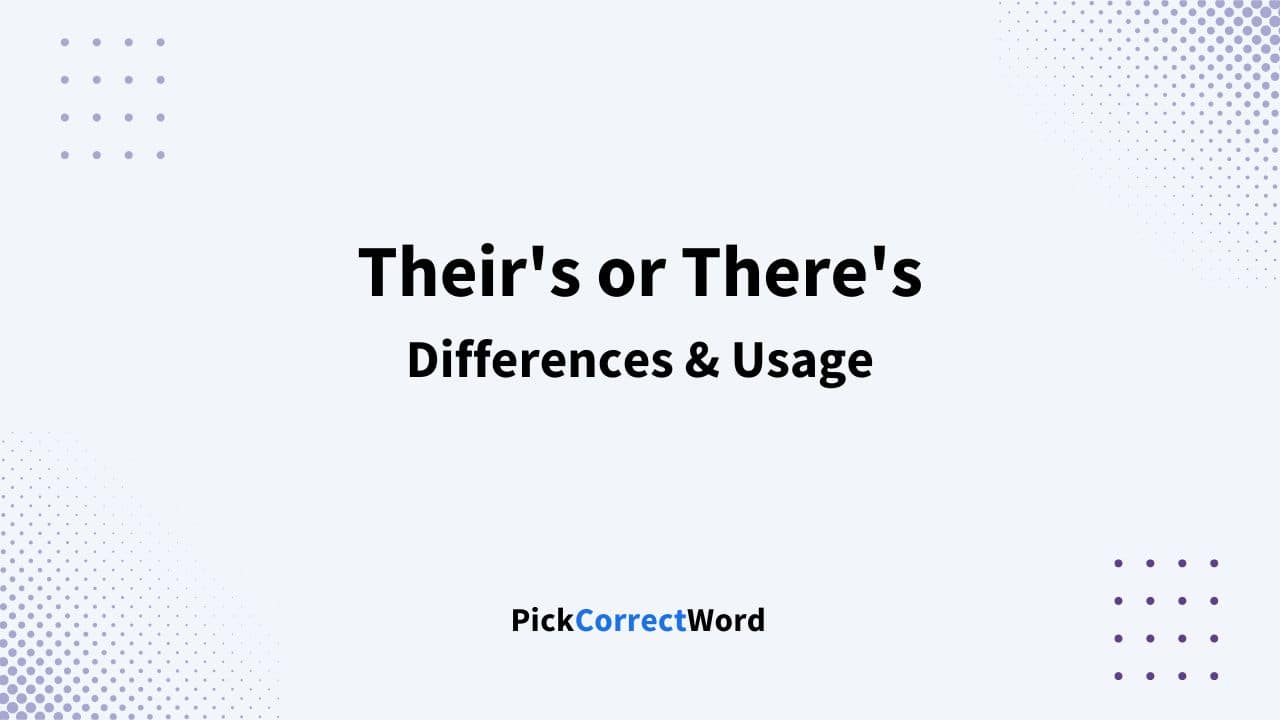When you’re writing or speaking, it’s important to pick the correct word, especially when dealing with words that sound alike.
For example, in your writing, you might be unsure about when to use their’s or there’s. The mix-up often happens because they sound similar. However, these two words have completely different meanings.
‘There’s’ is a contraction of ‘there is’ or ‘there has’. On the other hand, ‘their’s‘ is not grammatically correct. The right form is ‘theirs’, a possessive pronoun indicating ownership by someone.
Let’s go over the rules for using ‘their’s’ and ‘there’s’ correctly in your writing to help you avoid any confusion.
Their’s or There’s: Difference and usage
“There’s” is a proper and recognized word that you use to indicate the existence of something. It’s a shortened form of “there is” or “there has.”
On the other hand, “their’s” is not a correct spelling and isn’t a valid English word.
The key difference is that “there’s” points to the existence or location of something, acting as a place adverb. It always connects to what comes after and can usually be swapped with “there is” or “there are” without altering the meaning.
In contrast, “their’s” doesn’t have any meaning. But if you’re looking for the possessive version of the pronoun “their,” it’s “theirs”, without the apostrophe.
Understanding There’s
When you see “there’s,” you’re dealing with a shortened form that combines “there is.” This word often introduces something that exists or is present and acts as a location adverb, showing place.
There’s: Context of Use
You’ll use “there’s” when mentioning something that exists or is present, often when introducing a topic or pointing something out:
- Correct Usage: There’s a book on the table.
- Incorrect Usage: There’s are some cookies left. (Use “There are” for plural nouns)
Notice how “there’s” is used to signify that something exists or is present in a specific location. Always remember to pair “there’s” with singular nouns for correct use.
Understanding Their’s
At first sight, you might think “their’s” is a possessive pronoun, but it’s actually a common spelling mistake. In English, possessive pronouns like “theirs” don’t need an apostrophe.
Here are examples of the wrong and right way to use “their’s”:
- Incorrect: “This book isn’t mine, it must be their’s.”
- Correct: “This book isn’t mine, it must be theirs.”
In the first sentence, “their’s” is used incorrectly with an apostrophe, while in the second sentence, “theirs” is used correctly without an apostrophe.
So, when you want to show ownership and you’re tempted to use “their’s,” just use “theirs” without an apostrophe. Here are more examples for better understanding:
- The fault is theirs.
- The house at the end of the street is theirs.
- I have my own opinions, and they have theirs.
Why you don’t add an apostrophe to ‘theirs’
Adding an apostrophe to “theirs” is unnecessary and incorrect because “theirs” is already a possessive pronoun. It’s like other possessive words like “yours” or “ours”, which also don’t need apostrophes.
Examples of Using “There’s” in a Sentence
“There’s a book on your desk.“
“In the garden, there’s a beautiful oak tree.“
“There’s an intriguing story behind that painting.“
“Look under the table; there’s your missing sock.“
“There’s just one piece of cake left in the fridge.“
Examples of Using “Theirs” in a Sentence
“Remember that the notebook is theirs, not yours.“
“You might think that the victory was theirs, but you all played a part.“
“When you see the car in the driveway, know that it’s theirs.“
“If you find a lost puppy, ask around to see if it’s theirs.“
“The house at the end of the street is theirs; they just moved in last week.“
Frequently Asked Questions
How can one differentiate between ‘there’ and ‘their’ based on context?
In English, when you use ‘there’, you’re often talking about a place or using it to start a sentence. On the other hand, ‘their’ shows that something belongs to someone. To tell them apart, check if the word is telling you where something is or who owns something.
What situations call for the use of ‘there’ instead of ‘their’?
Use ‘there’ when referring to a place or point in space: “We will meet there at noon.” Also use it as a pronoun to introduce a sentence: “There are four apples in the basket.”
What are some tips to remember the correct usage of ‘there’, ‘their’, and ‘they’re’?
One tip is to remember that ‘their’ has the word ‘heir’ in it, which can imply inheritance or ownership. ‘There’ has the word ‘here’ in it, relating to a place or position. For ‘they’re,’ it’s a contraction of ‘they are,’ so checking if ‘they are’ fits in the sentence can determine its correctness.


